-
If you are posting pictures, and they aren't posting in the correct orientation, please flush your browser cache and try again.
Edge
Safari/iOS
Chrome
You are using an out of date browser. It may not display this or other websites correctly.
You should upgrade or use an alternative browser.
You should upgrade or use an alternative browser.
Lack of Significant Growth With Age -- Just A Southern Thing?
- Thread starter bigbendmarine
- Start date
S.T.Fanatic
5 year old buck +
The deer in my area take a big jump from 2-3. After that they don't seem to do a whole lot. Not many 6 year old or older bucks over the years though.
Triple C
5 year old buck +
This is our 11th season hunting my farm located in one of the highest harvest counties in the state as evidenced by the map and harvest data pics. As the crow flies, I’m prolly less than 3 miles from @WeedyJ’s place.

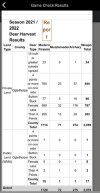
I’ve expressed my frustration over the years of watching most all the 3 yr old bucks disappear each fall as most get killed. For that matter, most of the 2 yr olds get killed. Some in the area say we don’t have the genetics to grow big deer when the truth is that we tend to kill most of em before they even have a chance to mature.
Here’s 8 of the 12 bucks we’ve taken off of my place in one of the most heavily hunted counties in the state. The southeast can produce big mature bucks but a 3 month long firearms season n 2 buck limit is not conducive to making that happen in most cases. We still love chasing them and the dream though!
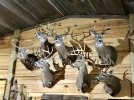



I’ve expressed my frustration over the years of watching most all the 3 yr old bucks disappear each fall as most get killed. For that matter, most of the 2 yr olds get killed. Some in the area say we don’t have the genetics to grow big deer when the truth is that we tend to kill most of em before they even have a chance to mature.
Here’s 8 of the 12 bucks we’ve taken off of my place in one of the most heavily hunted counties in the state. The southeast can produce big mature bucks but a 3 month long firearms season n 2 buck limit is not conducive to making that happen in most cases. We still love chasing them and the dream though!


I have spent a lot of time studying antler growth/ age correlation. Have probably let as many bucks die of old age as anyone just to see what happens. Couple of observations.
Nutrition definitely effects how well a deer ages and antler growth later in life. Suspect even the best soils in Fla with best management fall short of creating optimum nutrition. And even if it was done would take generations to see the genetic shift from previous generations of insufficient nutrition. This holds true to some degree or the other in most places.
Most subspecies of deer can grow their biggest racks much later in life than expected. Almost all of the best deer we have grown were 8 to 10. Again, they were on an extremely high nutritional plane. { Who knows if the 7 or 8 yr olds would have gotten bigger but sometimes they are. 'big enough'} I watched one of my best bucks ever from 4 to 10 where he grew his best rack 15-20" better than anything previously. While almost impossible to predict though, seems most of the biggest deer were always big relative to age.But not always . There are occasionally those rare deer that make the 30-40" jump .
Almost every deer we see makes a nice jump from 3 to 4. I believe it impossible to predict what most deer will do 3 and under. From 4 on though sometimes they go up, sometimes stay about the same and sometimes go down. Can drive you crazy! But for sure all of our best trophies got much much better later with 7 or 8 seeming to be the sweet spot both Mexico and La.
Everybody likes pics so here is a buck that made a 40"+ jump. Believed to be a 6 yr old in top pic. Almost let a guest shoot him as a 155" maybe bit more 8 pt but he broke up. The second pic is him the next yr as 7 or 8 yr old 210" .
One thing I know for sure...Nutrition and age are always your friend

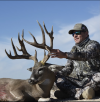
Nutrition definitely effects how well a deer ages and antler growth later in life. Suspect even the best soils in Fla with best management fall short of creating optimum nutrition. And even if it was done would take generations to see the genetic shift from previous generations of insufficient nutrition. This holds true to some degree or the other in most places.
Most subspecies of deer can grow their biggest racks much later in life than expected. Almost all of the best deer we have grown were 8 to 10. Again, they were on an extremely high nutritional plane. { Who knows if the 7 or 8 yr olds would have gotten bigger but sometimes they are. 'big enough'} I watched one of my best bucks ever from 4 to 10 where he grew his best rack 15-20" better than anything previously. While almost impossible to predict though, seems most of the biggest deer were always big relative to age.But not always . There are occasionally those rare deer that make the 30-40" jump .
Almost every deer we see makes a nice jump from 3 to 4. I believe it impossible to predict what most deer will do 3 and under. From 4 on though sometimes they go up, sometimes stay about the same and sometimes go down. Can drive you crazy! But for sure all of our best trophies got much much better later with 7 or 8 seeming to be the sweet spot both Mexico and La.
Everybody likes pics so here is a buck that made a 40"+ jump. Believed to be a 6 yr old in top pic. Almost let a guest shoot him as a 155" maybe bit more 8 pt but he broke up. The second pic is him the next yr as 7 or 8 yr old 210" .
One thing I know for sure...Nutrition and age are always your friend


Howboutthemdawgs
5 year old buck +
Curious about your line regarding even the best soils in Florida…what did you mean exactly about that? It was my understanding, from listening to Dr Harper, that soil doesn’t impact nutrition but rather it impacts yield. Are you saying there isn’t enough available nutrition (tonnage) there to allow deer to express their potential or that the habitat is deficient (planted pines, scrub oak, etc) or that the soil is not providing the plants with the nutrition needed to reach potential? Once again just regurgitating what I listened to, but he implied ragweed is ragweed whether it is grown in the coastal plain or in the Midwest but it was the abundance that was the limiting factor in poor soils.I have spent a lot of time studying antler growth/ age correlation. Have probably let as many bucks die of old age as anyone just to see what happens. Couple of observations.
Nutrition definitely effects how well a deer ages and antler growth later in life. Suspect even the best soils in Fla with best management fall short of creating optimum nutrition. And even if it was done would take generations to see the genetic shift from previous generations of insufficient nutrition. This holds true to some degree or the other in most places.
Most subspecies of deer can grow their biggest racks much later in life than expected. Almost all of the best deer we have grown were 8 to 10. Again, they were on an extremely high nutritional plane. { Who knows if the 7 or 8 yr olds would have gotten bigger but sometimes they are. 'big enough'} I watched one of my best bucks ever from 4 to 10 where he grew his best rack 15-20" better than anything previously. While almost impossible to predict though, seems most of the biggest deer were always big relative to age.But not always . There are occasionally those rare deer that make the 30-40" jump .
Almost every deer we see makes a nice jump from 3 to 4. I believe it impossible to predict what most deer will do 3 and under. From 4 on though sometimes they go up, sometimes stay about the same and sometimes go down. Can drive you crazy! But for sure all of our best trophies got much much better later with 7 or 8 seeming to be the sweet spot both Mexico and La.
Everybody likes pics so here is a buck that made a 40"+ jump. Believed to be a 6 yr old in top pic. Almost let a guest shoot him as a 155" maybe bit more 8 pt but he broke up. The second pic is him the next yr as 7 or 8 yr old 210" .
One thing I know for sure...Nutrition and age are always your friend
View attachment 39194View attachment 39195
While I agree with the work of Dr. Harper I think you hit on the limiters. Not only do weak soils grow less tonnage the plant specie mix is different with lower quality plants. I have no personal experience in Fla but a couple anecdotal observations seem material. Body weights are much less there than in stronger habitats. Also look at the Keys deer, midgets much like the coues deer which are also in weak habitat. Generationally they genetically adapted to their weak environment. Would take a long time to shift to be competitive with higher quality habitats.
TreeDaddy
5 year old buck +
While I agree with the work of Dr. Harper I think you hit on the limiters. Not only do weak soils grow less tonnage the plant specie mix is different with lower quality plants. I have no personal experience in Fla but a couple anecdotal observations seem material. Body weights are much less there than in stronger habitats. Also look at the Keys deer, midgets much like the coues deer which are also in weak habitat. Generationally they genetically adapted to their weak environment. Would take a long time to shift to be competitive with higher quality habitats.
As such, central texas produce deer the size of Cocker Spaniels......
bill
Nightvision
5 year old buck +
It has to matter imo and here’s why.Curious about your line regarding even the best soils in Florida…what did you mean exactly about that? It was my understanding, from listening to Dr Harper, that soil doesn’t impact nutrition but rather it impacts yield. Are you saying there isn’t enough available nutrition (tonnage) there to allow deer to express their potential or that the habitat is deficient (planted pines, scrub oak, etc) or that the soil is not providing the plants with the nutrition needed to reach potential? Once again just regurgitating what I listened to, but he implied ragweed is ragweed whether it is grown in the coastal plain or in the Midwest but it was the abundance that was the limiting factor in poor soils.
Wild pheasants have been stocked in the south many times but they never make it. A biologist told me it’s not that they don’t breed and lay eggs but that the eggs break when the hens sit on them. The reason being that we do not have enough calcium in the soil so their eggs are thinner and more fragile.
If a low calcium content affects the eggs of a hen pheasant how much do all of the extra nutrients in the Midwest soils help the whitetails? And has been helping them for decades.
Bassattackr
5 year old buck +
It has to matter imo and here’s why.
Wild pheasants have been stocked in the south many times but they never make it. A biologist told me it’s not that they don’t breed and lay eggs but that the eggs break when the hens sit on them. The reason being that we do not have enough calcium in the soil so their eggs are thinner and more fragile.
If a low calcium content affects the eggs of a hen pheasant how much do all of the extra nutrients in the Midwest soils help the whitetails? And has been helping them for decades.
Something else to keep in mind.. Soil (like anything else) can be altered. Calcium is easily added thru Gypsum (Calcium Sulfate) or higher Ca (Calcitic) Lime, both common inputs for ag fields as it can be a limiter in crop production.
Wasn't it also Dr. Harper that said in heavily managed Ga properties, it was only 2 or 3 generations for bucks to increase their antler size dramatically? Maybe Don Higgins? I believe due to fetal programming.. The genetics were always there, but until the nutrients were placed (feed, mineral sites, etc.) for the does to absorb, they were never expressed by their offspring buck(s).
Nightvision
5 year old buck +
Something else to keep in mind.. Soil (like anything else) can be altered. Calcium is easily added thru Gypsum (Calcium Sulfate) or higher Ca (Calcitic) Lime, both common inputs for ag fields as it can be a limiter in crop production.
Wasn't it also Dr. Harper that said in heavily managed Ga properties, it was only 2 or 3 generations for bucks to increase their antler size dramatically? Maybe Don Higgins? I believe due to fetal programming.. The genetics were always there, but until the nutrients were placed (feed, mineral sites, etc.) for the does to absorb, they were never expressed by their offspring buck(s).
Who knows? All I know is a fellow with deep pockets tried getting them started on property next to my parents. Had feeders everywhere. He couldn’t manage all of the soil on 1200 acres but did on his food plots. We had pheasants around for a couple of years but never saw a baby pheasant. That’s where I spoke to the biologist.
He also wanted trout in his ponds. Our water gets way too hot for trout. So what do you do when you have way too much money? Build the pond, stick the trout, and keep the water cooled with liquid oxygen.
bigbendmarine
5 year old buck +
Baker, fully agree that the observations you shared play a key role in limitations for Florida bucks in general, but that said lumping Florida bucks in one bag is somewhat akin to lumping Texas deer together, with Texas big enough to make for quite a bit of variation habitat and deer quality wise. I lived in Lubbock for 3 years while my wife did her residency with Texas Tech, and geographically speaking Lubbock couldn't have been much more different than East Texas. Along those lines, as the crow flies I'm actually closer to Nashville and Knoxville than I am to the Keys and key deer.
And to refocus the thread / or end it with note of clarification... speaking to my original intent of posting, it was NOT to cry about southern deer being smaller than northern deer but instead to question whether having a portion of bucks really put on mass both body wise and horn wise in comparison to another portion not changing much is a universal phenomenon regardless of quality of habitat.
And at the risk of really derailing my own thread, I also appreciate that I could spend big money / devote much time / take specific actions to dramatically improve the local deer herd, but honestly don't have interest in going that far... at least not at this point in my life as my wife and I run a business that demands too much of my time. I'm NOT casting stones at those of you that do, instead MUCH appreciating some of the wisdom it helps y'all bring to the table... just saying not my cup of tea at this time... with that said, here are some "Florida deer" growing in my county and neighboring counties... with quite a bit of supplemental care and with the deer not exactly free to range wherever they might otherwise.
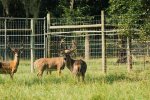
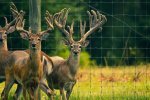
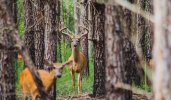
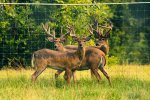
And to refocus the thread / or end it with note of clarification... speaking to my original intent of posting, it was NOT to cry about southern deer being smaller than northern deer but instead to question whether having a portion of bucks really put on mass both body wise and horn wise in comparison to another portion not changing much is a universal phenomenon regardless of quality of habitat.
And at the risk of really derailing my own thread, I also appreciate that I could spend big money / devote much time / take specific actions to dramatically improve the local deer herd, but honestly don't have interest in going that far... at least not at this point in my life as my wife and I run a business that demands too much of my time. I'm NOT casting stones at those of you that do, instead MUCH appreciating some of the wisdom it helps y'all bring to the table... just saying not my cup of tea at this time... with that said, here are some "Florida deer" growing in my county and neighboring counties... with quite a bit of supplemental care and with the deer not exactly free to range wherever they might otherwise.




bigbendmarine
5 year old buck +
And even with the share of the crazy horn pics, think the pics speak to Bill's comment on the challenge of aging some Southern deer on the hoof. Big as the horns are in the pics immediately above, look closely at those pics and bodies still show fair amount of variability in trying to judge maturity. Few bucks I've felt comfortable speaking to age on my place were due to recognizable features such as split-ear patterns, color markings, and to a degree mass of racks and especially gnarly growth along the brow tine base area. Guessing this mostly goes back to Bergmann's rule and body size increases with colder temps, which again I know supports the "southern deer won't NATURALLY be turned into northern deer."
On a slightly humorous note, got ONE single buck who made two nighttime visits to our place late in November I'd love to share as an exception to the rule... but rather wait to he's resting on the dirt than jinx myself sharing pics of him in advance.
On a slightly humorous note, got ONE single buck who made two nighttime visits to our place late in November I'd love to share as an exception to the rule... but rather wait to he's resting on the dirt than jinx myself sharing pics of him in advance.
Mortenson
5 year old buck +
Wish I could add my buck to the thread titled something about letting them go so they can grow, but I think this thread is more for him. It's just another example of a healthy, mature buck in the heart of the midwest failing to crack 140". This buck most likely spent a lot of his summers eating plants grown on muscatune soil, IL's highest rated soil (for corn and beans) from nearly a thousand types. Best guess is he was 5.5 this year. I'd need to get my old pics from the cloud to dig more closely, but from what I have saved in my phone, I can share 3 years anyhow. He mainly spent only late fall and winter on our farm based on my limited knowledge. Wasn't a huge bodied buck. Guessing dressed 190-200.
Age 3.5 unless anyone wants to suggest otherwise:
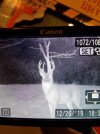

Age 4.5 made a very modest jump and added 2 tines:
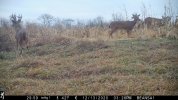
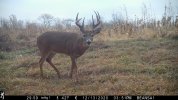
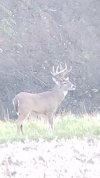
Age 5.5 can't really say that he put many inches on, lost a point, maybe gained a hair in mass, didn't get many good daylight pics:
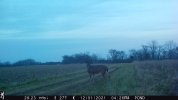
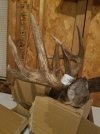
Age 3.5 unless anyone wants to suggest otherwise:


Age 4.5 made a very modest jump and added 2 tines:



Age 5.5 can't really say that he put many inches on, lost a point, maybe gained a hair in mass, didn't get many good daylight pics:


Compared to the deer I see here in eastern N.C. he's hugeWish I could add my buck to the thread titled something about letting them go so they can grow, but I think this thread is more for him. It's just another example of a healthy, mature buck in the heart of the midwest failing to crack 140". This buck most likely spent a lot of his summers eating plants grown on muscatune soil, IL's highest rated soil (for corn and beans) from nearly a thousand types. Best guess is he was 5.5 this year. I'd need to get my old pics from the cloud to dig more closely, but from what I have saved in my phone, I can share 3 years anyhow. He mainly spent only late fall and winter on our farm based on my limited knowledge. Wasn't a huge bodied buck. Guessing dressed 190-200.
Age 3.5 unless anyone wants to suggest otherwise:
View attachment 39244View attachment 39245
Age 4.5 made a very modest jump and added 2 tines:
View attachment 39246View attachment 39247View attachment 39248
Age 5.5 can't really say that he put many inches on, lost a point, maybe gained a hair in mass, didn't get many good daylight pics:
View attachment 39249View attachment 39250

That's stretching it but he does as much mass as any deer Ive seen here.
Sent from my LG-US996 using Tapatalk
bigbendmarine
5 year old buck +
Full-year delay in responding to this post which I believe was filled with good discussion on lots of variables impacting growth of deer in varying regions.
Actually recently harvested the buck that drove me to create the post in the first place and there's a bit of a follow-up story to tell.
While I can't swear how much it impacted his horn growth, I can share he had been dealing with a progressively crippling injury for over a year and a half (maybe even longer). I know he was at least 4 1/2 years old this winter (very distinct set of small splits in his ear since a year old) and still carried a very similar 8-point rack this year though it had picked up a bit of mass along most of the base. If anything angle of photo is complimentary though not with intent -- hunting alone just was the easiest picture for me to get before hanging him to process him.
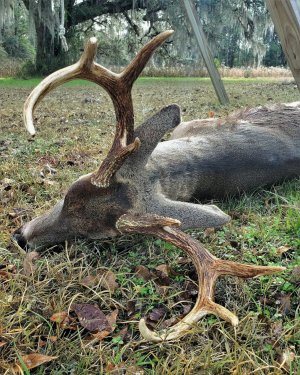
Now to speak to the injury, I noticed in trail camera captures I had of him that he was often hobbling quite badly with something obviously wrong with his front left leg. When he put weight on it, it was almost like he had a peg leg that he would put forward before lurching forward on it. He wasn't near death or anything, but he definitely was submissive throughout the summer to other bucks in his bachelor group I don't think he would have been had he not had the injury. And it seemed the pain varied at times as I STILL managed to see him chase does from our house a few times, run, and even jump into cover... but then I'd see him hobbling a bit more than before on subsequent camera captures.
He only weighed 140 pounds when I made the decision to take him -- light even for our area where mature bucks tend to weigh at least 10 to 20 pounds more. Having seen him only once from a stand last year, I decided to shoot him as he slipped up for the first time right before the New Year. I don't think he was at immediate threat of coyotes getting him, but I do believe he was going to be at an increased risk of being attached if his lameness kept progressing.
Here's a picture showing just how different his two front legs were -- injured one was permanently swollen with the swollen joint hard as a rock, hooves on that leg angled at almost 45 degrees inward (leg on the left of the picture was the deer's left leg -- should have placed it on the other side with the hooves turning inward toward the straight leg), and though the back looked healed, he was missing an entire dew claw. After seeing how much the leg was affected I went back to old game capture cameras and could tell he had a slight limp on the same leg at least 16 months back, something I may have noticed at the time but if so likely chalked up to a possible fight -- have had numerous bucks limp a while after getting beat up by other bucks.
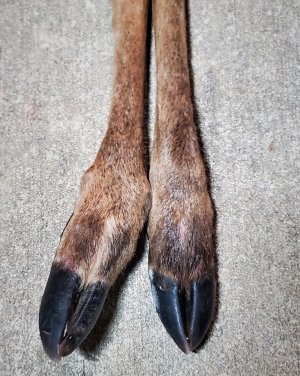
Meanwhile, as Florida goes had a pretty nice "ghost buck" show up about a week ago though I spotted him from the house versus from a stand. Even just looking at him from a window about 100 yards away as darkness fell he still was wary enough to stare in my direction for a good 5 minutes before he risked feeding a minute and then disappeared into the treeline. Heard two gunshots from neighboring properties this weekend, so not even sure he's still around. Only time will tell.
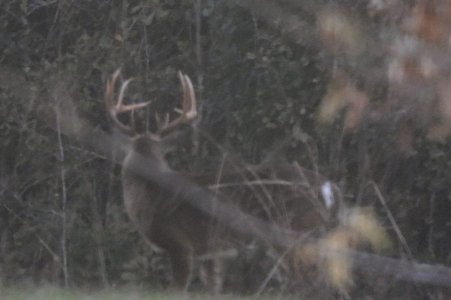
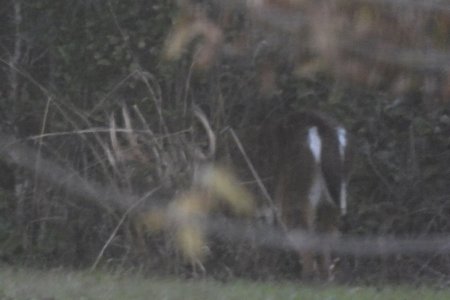
Actually recently harvested the buck that drove me to create the post in the first place and there's a bit of a follow-up story to tell.
While I can't swear how much it impacted his horn growth, I can share he had been dealing with a progressively crippling injury for over a year and a half (maybe even longer). I know he was at least 4 1/2 years old this winter (very distinct set of small splits in his ear since a year old) and still carried a very similar 8-point rack this year though it had picked up a bit of mass along most of the base. If anything angle of photo is complimentary though not with intent -- hunting alone just was the easiest picture for me to get before hanging him to process him.

Now to speak to the injury, I noticed in trail camera captures I had of him that he was often hobbling quite badly with something obviously wrong with his front left leg. When he put weight on it, it was almost like he had a peg leg that he would put forward before lurching forward on it. He wasn't near death or anything, but he definitely was submissive throughout the summer to other bucks in his bachelor group I don't think he would have been had he not had the injury. And it seemed the pain varied at times as I STILL managed to see him chase does from our house a few times, run, and even jump into cover... but then I'd see him hobbling a bit more than before on subsequent camera captures.
He only weighed 140 pounds when I made the decision to take him -- light even for our area where mature bucks tend to weigh at least 10 to 20 pounds more. Having seen him only once from a stand last year, I decided to shoot him as he slipped up for the first time right before the New Year. I don't think he was at immediate threat of coyotes getting him, but I do believe he was going to be at an increased risk of being attached if his lameness kept progressing.
Here's a picture showing just how different his two front legs were -- injured one was permanently swollen with the swollen joint hard as a rock, hooves on that leg angled at almost 45 degrees inward (leg on the left of the picture was the deer's left leg -- should have placed it on the other side with the hooves turning inward toward the straight leg), and though the back looked healed, he was missing an entire dew claw. After seeing how much the leg was affected I went back to old game capture cameras and could tell he had a slight limp on the same leg at least 16 months back, something I may have noticed at the time but if so likely chalked up to a possible fight -- have had numerous bucks limp a while after getting beat up by other bucks.

Meanwhile, as Florida goes had a pretty nice "ghost buck" show up about a week ago though I spotted him from the house versus from a stand. Even just looking at him from a window about 100 yards away as darkness fell he still was wary enough to stare in my direction for a good 5 minutes before he risked feeding a minute and then disappeared into the treeline. Heard two gunshots from neighboring properties this weekend, so not even sure he's still around. Only time will tell.


Last edited:
Telemark
5 year old buck +
but he implied ragweed is ragweed whether it is grown in the coastal plain or in the Midwest
If that's what he said, I think he is mistaken. Plants can certainly have nutrient deficiencies. A change in pH can affect a plant's ability to take up nutrients. Farmers and food plotters make all kinds of changes to their soil to improve plant health. Various laboratories will even do tissue analysis to test nutrient levels in the plants.
This is in addition to the logical fallacy that such a statement requires deer density to be even and equal over all soil types for the difference in food density to matter.
Telemark
5 year old buck +
Full-year delay in responding to this post which I believe was filled with good discussion on lots of variables impacting growth of deer in varying regions.
Actually recently harvested the buck that drove me to create the post in the first place and there's a bit of a follow-up story to tell.
While I can't swear how much it impacted his horn growth, I can share he had been dealing with a progressively crippling injury for over a year and a half (maybe even longer). I know he was at least 4 1/2 years old this winter (very distinct set of small splits in his ear since a year old) and still carried a very similar 8-point rack this year though it had picked up a bit of mass along most of the base. If anything angle of photo is complimentary though not with intent -- hunting alone just was the easiest picture for me to get before hanging him to process him.
View attachment 48593
Now to speak to the injury, I noticed in trail camera captures I had of him that he was often hobbling quite badly with something obviously wrong with his front left leg. When he put weight on it, it was almost like he had a peg leg that he would put forward before lurching forward on it. He wasn't near death or anything, but he definitely was submissive throughout the summer to other bucks in his bachelor group I don't think he would have been had he not had the injury. And it seemed the pain varied at times as I STILL managed to see him chase does from our house a few times, run, and even jump into cover... but then I'd see him hobbling a bit more than before on subsequent camera captures.
He only weighed 140 pounds when I made the decision to take him -- light even for our area where mature bucks tend to weigh at least 10 to 20 pounds more. Having seen him only once from a stand last year, I decided to shoot him as he slipped up for the first time right before the New Year. I don't think he was at immediate threat of coyotes getting him, but I do believe he was going to be at an increased risk of being attached if his lameness kept progressing.
Here's a picture showing just how different his two front legs were -- injured one was permanently swollen with the swollen joint hard as a rock, hooves on that leg angled at almost 45 degrees inward (leg on the left of the picture was the deer's left leg -- should have placed it on the other side with the hooves turning inward toward the straight leg), and though the back looked healed, he was missing an entire dew claw. After seeing how much the leg was affected I went back to old game capture cameras and could tell he had a slight limp on the same leg at least 16 months back, something I may have noticed at the time but if so likely chalked up to a possible fight -- have had numerous bucks limp a while after getting beat up by other bucks.
View attachment 48595
Meanwhile, as Florida goes had a pretty nice "ghost buck" show up about a week ago though I spotted him from the house versus from a stand. Even just looking at him from a window about 100 yards away as darkness fell he still was wary enough to stare in my direction for a good 5 minutes before he risked feeding a minute and then disappeared into the treeline. Heard two gunshots from neighboring properties this weekend, so not even sure he's still around. Only time will tell.
View attachment 48596
View attachment 48597
That's an interesting story. I guess you at least partially solved the mystery. I'm a bit envious of you guys who can keep tabs on your deer. It seems to make the whole habitat hobby more rewarding.
Brian662
5 year old buck +
Hard to tell exactly from that angle everything that's going on, but that one looks 160"+ to me, the ghost. Stud buckFull-year delay in responding to this post which I believe was filled with good discussion on lots of variables impacting growth of deer in varying regions.
Actually recently harvested the buck that drove me to create the post in the first place and there's a bit of a follow-up story to tell.
While I can't swear how much it impacted his horn growth, I can share he had been dealing with a progressively crippling injury for over a year and a half (maybe even longer). I know he was at least 4 1/2 years old this winter (very distinct set of small splits in his ear since a year old) and still carried a very similar 8-point rack this year though it had picked up a bit of mass along most of the base. If anything angle of photo is complimentary though not with intent -- hunting alone just was the easiest picture for me to get before hanging him to process him.
View attachment 48593
Now to speak to the injury, I noticed in trail camera captures I had of him that he was often hobbling quite badly with something obviously wrong with his front left leg. When he put weight on it, it was almost like he had a peg leg that he would put forward before lurching forward on it. He wasn't near death or anything, but he definitely was submissive throughout the summer to other bucks in his bachelor group I don't think he would have been had he not had the injury. And it seemed the pain varied at times as I STILL managed to see him chase does from our house a few times, run, and even jump into cover... but then I'd see him hobbling a bit more than before on subsequent camera captures.
He only weighed 140 pounds when I made the decision to take him -- light even for our area where mature bucks tend to weigh at least 10 to 20 pounds more. Having seen him only once from a stand last year, I decided to shoot him as he slipped up for the first time right before the New Year. I don't think he was at immediate threat of coyotes getting him, but I do believe he was going to be at an increased risk of being attached if his lameness kept progressing.
Here's a picture showing just how different his two front legs were -- injured one was permanently swollen with the swollen joint hard as a rock, hooves on that leg angled at almost 45 degrees inward (leg on the left of the picture was the deer's left leg -- should have placed it on the other side with the hooves turning inward toward the straight leg), and though the back looked healed, he was missing an entire dew claw. After seeing how much the leg was affected I went back to old game capture cameras and could tell he had a slight limp on the same leg at least 16 months back, something I may have noticed at the time but if so likely chalked up to a possible fight -- have had numerous bucks limp a while after getting beat up by other bucks.
View attachment 48595
Meanwhile, as Florida goes had a pretty nice "ghost buck" show up about a week ago though I spotted him from the house versus from a stand. Even just looking at him from a window about 100 yards away as darkness fell he still was wary enough to stare in my direction for a good 5 minutes before he risked feeding a minute and then disappeared into the treeline. Heard two gunshots from neighboring properties this weekend, so not even sure he's still around. Only time will tell.
View attachment 48596
View attachment 48597
Nice looking one you tagged as well!
Buckhunter10
5 year old buck +
Wow great thread.
I just would add that anyone interested would love the book Strategic Harvest Systems by Dr. Bronson Strickland - it talks about this very topic and how epigentic triggers are “flipped” on in deer as nutritional value is increased. This can be through habitat manipulation and/or adequate harvests. After a few generations - the results were staggering!! Even on deer from regions “that don’t produce big bucks” - lower costal plains of Mississippi deer matched Mississippi Delta deer antler outputs.
Amazing!!
I just would add that anyone interested would love the book Strategic Harvest Systems by Dr. Bronson Strickland - it talks about this very topic and how epigentic triggers are “flipped” on in deer as nutritional value is increased. This can be through habitat manipulation and/or adequate harvests. After a few generations - the results were staggering!! Even on deer from regions “that don’t produce big bucks” - lower costal plains of Mississippi deer matched Mississippi Delta deer antler outputs.
Amazing!!
Similar threads
- Replies
- 30
- Views
- 665
